Liposomal vitamin C
 I have carried out many experiments on ways to make liposomal vitamin c and my findings are as show below. I had an allergic reaction to the lecithin in the liposomal vitamin c and contacted Andrew of the UK (see my previous article on liposomal vitamin c) about it. He informed me that the allergic reactions was due to the soy proteins in the lecithin.
I have carried out many experiments on ways to make liposomal vitamin c and my findings are as show below. I had an allergic reaction to the lecithin in the liposomal vitamin c and contacted Andrew of the UK (see my previous article on liposomal vitamin c) about it. He informed me that the allergic reactions was due to the soy proteins in the lecithin.
Basically, I had itching on both my wrists when I consumed liposomal vitamin c. Even though the itching was mild it was irritating and very distracting. Andrew had suggested that if you are sensitive to lecithin from soy beans you could try lecithin from sunflowers. I could not get sunflower lecithin and found an alternative solution that could help many people. I do hope this article does help many people.
Once I knew that the proteins were the cause of the allergic reaction I knew that there was one more experiment that I could try to knock off the allergy.
Video on liposomal vitamin c
Andrew had provide me with another video, the NZ video, on lipsomal vitamin c and do view the video as it will be educational for many of us. Click here to view the NZ video the on liposomal vitmain c.
The experiments making liposomal vitamin c
Over the last few weeks I had carried out many experiments, making and consuming, lipsomal vitamin c. The original formulation I had used for liposomal vitamin c was
| The Liposomal Vitamin C | ||||
| Item | Ingredients | Percentage | Weight | Weight |
| (%) | (g) | oz. | ||
| 1 | Vitamin C (powder form) | 100 | 20 | 0.704 |
| 2 | Water | 800 | 160 | 5.632 |
| 3 | Lecithin granules | 250 | 50 | 1.76 |
In recent days I have tried making liposomal vitamin c with less lecithin and more vitamin C to increase the absorbtion of vitamin c. I found many associated difficulties trying to increase the vitamin c content as there is only so much vitamin c that could be dissolved in water. From experiments I noticed that you will need eight times the weight of water to dissolve a certain weight of vitamin c. This means that for every 20g of vitamin c you would need about 160g of water for it to dissolve into solution.
Photos of the liposomal vitamin C experimental results
I tried saturating the vitamin c in 160g of water just by trying to add 100g of vitamin c and later 80g of vitamin c in 160g of water even though the excess would not dissolve, then ultrasonic mixing it.
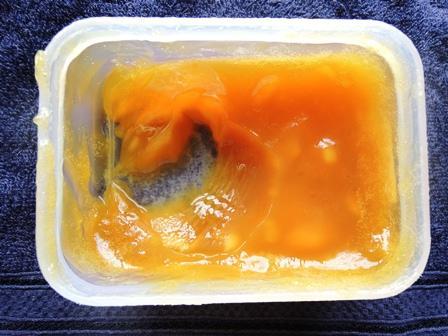
In the above experiment I had used 70g of lecithin so it does look jelly like. I had tried to ‘force’ 80g of vitamin c into mixture and as you can see the vitamin c precipitated out of the mixture, the next day. You can see the large white lumps in the picture. Those are the excess vitamin c lumps. This was definitely a waste of vitamin c.

I then tried 50g of lecithin blended in a blender with 20g of vitamin c and 160g of water and as you can see in the photo above it did separate out. Actually it separated out the next day after over night refrigeration.
After many experiments I found that if I did not refrigerate the liposomal viatmin c mixture it could last a lot longer before the lecithin separates from the vitmain c. It did appear to be more than two or three days. Do keep the liposomal vitamin c in a cool cupboard away from direct sunlight. You can do a simple test to see if there is separation of the vitamin c from the lecithin in the liposomal vitamin c mixture. Taste it and you will notice that it will become more and more sour each day. This would indicate that less and less lecithin was encapsulating the vitamin c.
Do note that a high dosage vitamin c, if not encapsulated in lecithin, will cause purging. This is probably not the best way to find out that your liposomal vitmain c has broken down.
Stopping the allergic reaction to the lecithin
Once Andrew informed me that the allergic reaction was caused by the soy proteins I guessed at a possible solution. Proteins are denatured when heated above 70C (158F) so that was what I tried. I knew I could not put the lecithin granules into a hot pan to denature the proteins as the pan temperature cannot be controlled and could easily shoot far higher. At a higher temperature some other reaction takes place. The lecithin will turn black and I would not know if it still was lecithin or decomposed into something else.
To safely set the heating at a fixed temperature I tried steaming the lecithin. Steaming always ensures that the temperature does not go above 100C (212F). I tried steaming the lecithin for 10 minutes, for 30 minutes and longer and found that after steaming the lecithin for one hour, my body did not show any allergic reaction to the lecithin. When I had steamed the lecithin for 30 minutes there was some much milder allergic reaction.
This was a good way to stop the allergic reaction in liposomal vitamin c. There was an additional benefit to steaming and that is that some brands of lecithin granules had a nauseous smell and steaming removed that smell. Do not steam vitamin c as vitamin c is destroyed by heat. Below is how I denatured the proteins in the lecithin.
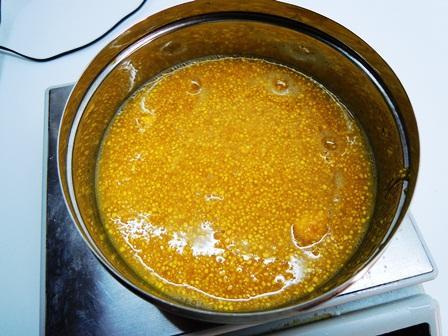
Add equal amount of water to the weight of the lecithin you are to steam. I took advantage of the steaming process to rehydrate the lecithin by adding water into the lecithin granules. If you have read any of my previous article on lecithin granules you would know that lecithin granules do not behave like lecithin. They had to be re-hydrated first before they behaved like lecithin.
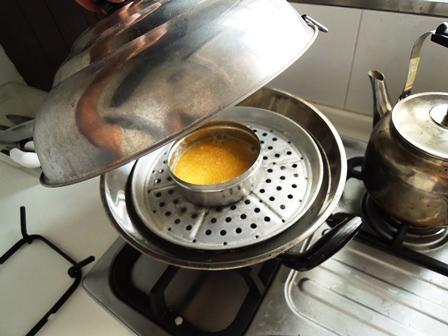
Steam the lecithin and water mixture for an hour.

At the end of an hour the lecithin and water mixture would look like a jelly. If you do not have a steamer, you could probably try heating the above lecithin and water mixture in an oven set at 100C (212F).
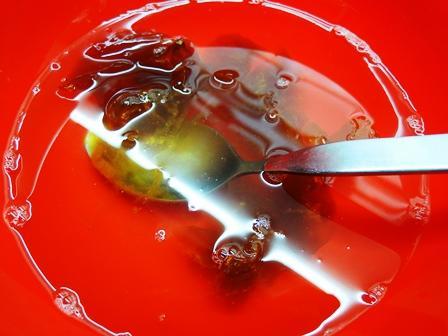
Allow the lecithin jelly to cool to room temperature then add the lecithin jelly into the saturated vitamin c solution – 20g of vitamin c mixed in 160g of water. I tried waiting another hour but it did not make any visible difference to the would be liposomal viatmin c mixture. I put the mixture into a blender and blended it for a few minutes. Sorry I forgot to take pictures of the blending of the liposomal vitamin c operation. I had used a blender to mix the liposomal vitamin c as I thought it would distribute the lecithin uniformly in the vitamin c solution.

Pour the mixture into the ultrasonic cleaner to ultrasonic mix the lecithin and vitamin c to make liposomal vitmain c. I ultrasonic mixed the liposomal vitamin c mixture for ten minutes and rested the machine for 20 minutes and then ultrasonic mixed again for another 10 minutes. This was to ensure I really got a good ultrasonic mix, just to be on the safe side – not sure if it is required as it looks like a 10 minute mix may be sufficient.
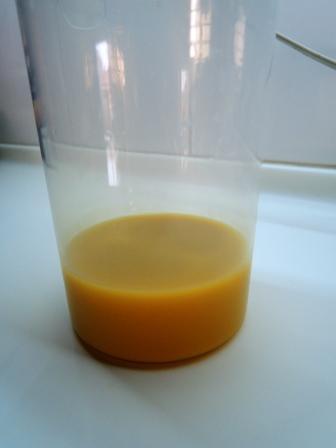
The final liposomal vitamin c. I did not keep it in the fridge and liposomal vitamin c lasted a few days without separating out that much.
If you are new to liposomal vitamin c, do view the videos in my previous article on liposomal vitamin c and do view the NZ video on liposomal vitamin c. Do take note of the texture of the liposomal vitamin c in the NZ video.
At this moment I am not sure if using the blender really helped make the liposomal vitamin c effective. I would have to try another experiment on liposomal vitamin c without the blender. Do note I am not an expert on liposomal vitamin c and am trying out experiments to find out a good method of making it.
More of lecithin and liposomal vitamin C
8.How to make liposomal vitamin c gel
7.How to make oregano liposomal vitamin c
6.More experiments with liposomal vitamin c
5.how to make lecithin liposomal vitamin C
4.lecithin and carotino oil blend
3.Recovering soy lecithin granules properties – the lecithin blend
2.Comparison of soy lecithin granules, lecithin capsules and raw lecithin
1.How to make low fat butter spread
Please do click on the facebook and Google+ like buttons if you found this article informative and useful.
This article on More experiments with liposomal vitamin c was researched and written by Peter Achutha
Leave a Reply